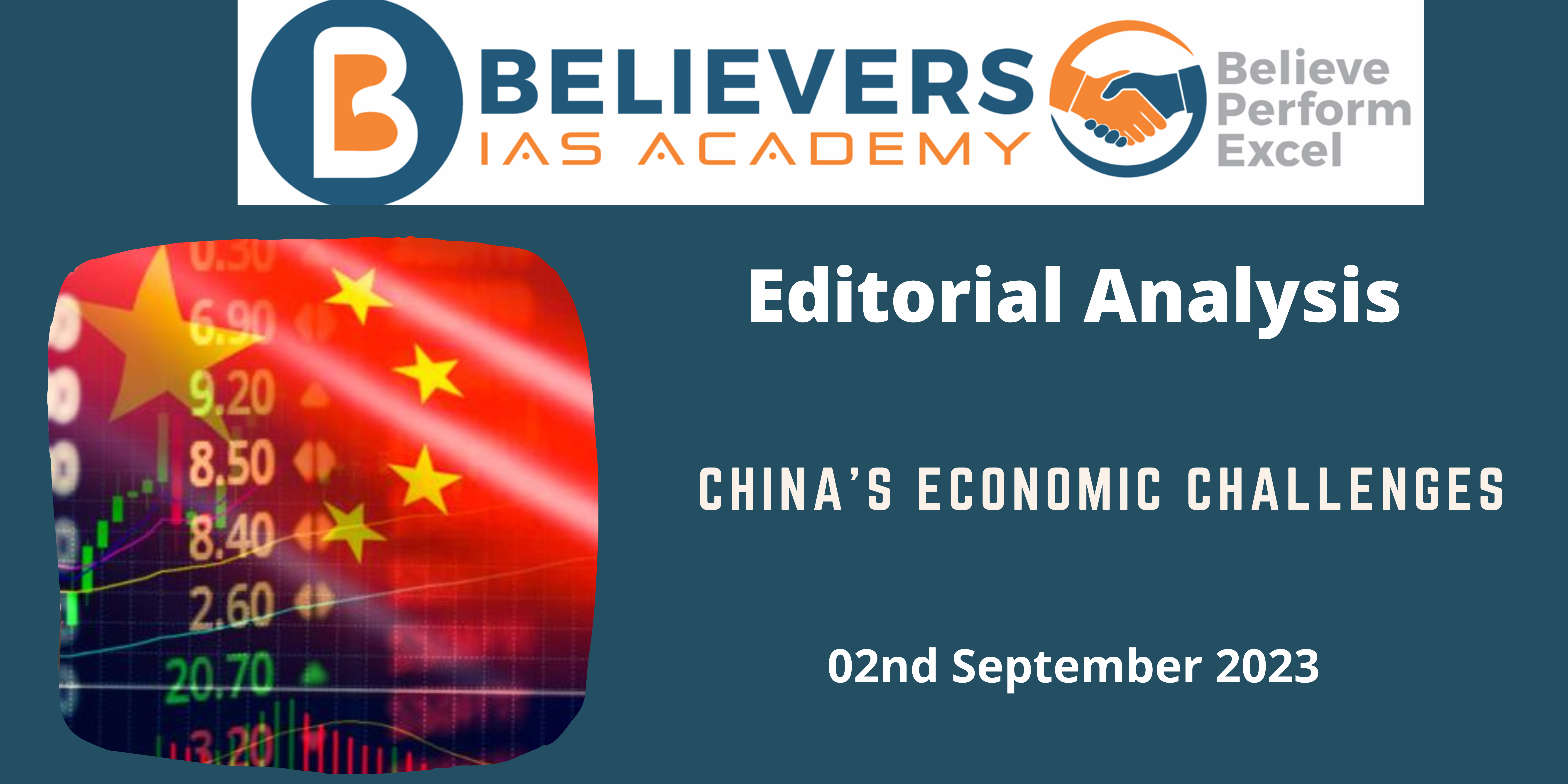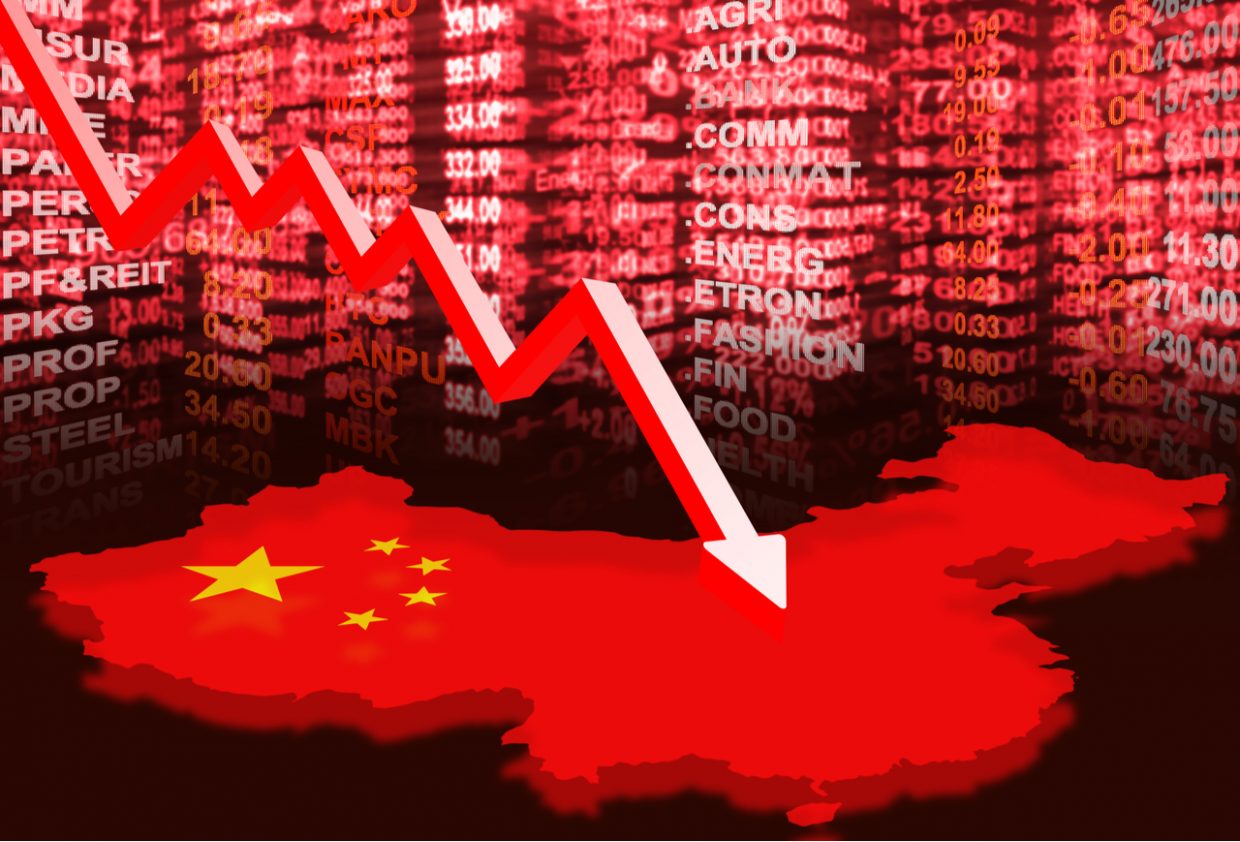China’s Economic Challenges
Context:
The recent news of China’s economic slowdown has stirred a mixed bag of reactions. For years, China has grappled with concerns about economic deceleration and the dreaded middle-income trap. Now the ongoing deflation is casting a shadow not only over China but the global economy as well.
Relevance:
GS – 03 (Growth & Development, Monetary Policy, Fiscal Policy)
Prelims:
- Concerns of Over Deflation in China
- Consumer Price Index
- Deflation
- Inflation
- Gross Domestic Product
- Debts
Mains Question:
- Prioritizing the quality of life as a part of their growth strategy is the new normal for any country. Comment. 150 words.
Implications for India:
- Trade Balance: China may reduce its imports, affecting various sectors such as electronics, pharmaceuticals, and agriculture. India needs to diversify its export destinations to mitigate this risk.
- Commodity Prices: China is a major consumer of commodities, and its reduced demand can lead to a fall in global commodity prices. This could benefit India as it’s a net importer of commodities like crude oil and metals, leading to lower input costs for Indian industries.
- Investment: A slowdown in China might redirect Chinese FDI towards other destinations, including India, potentially boosting the Indian economy.
- Manufacturing Competitiveness: As China’s labor costs rise, India becomes more attractive as a manufacturing destination. India can capitalize on this by improving its infrastructure and ease of doing business to attract companies looking to relocate their manufacturing operations.
- Geopolitical Dynamics: India needs to closely monitor China’s actions, especially along the border areas, as economic instability might affect China’s risk appetite and potentially impact the existing border tensions between the two countries.
Dimensions of the Article:
- The Era of Unstable Growth
- The “New Normal” Realities
- Labor Costs and Sectoral Imbalances
- A Complex Political Economy
- The Ever Grande Crisis and Housing Bubble
- Economic Instability’s Ripple Effect
The Era of Unstable Growth:
- In 2007, the then Premier Wen Jiabao candidly pointed out that China’s economy suffered from instability, imbalance, lack of coordination, and unsustainability. This acknowledgment set the stage for potential corrective actions.
- However, when the global financial crisis hit in 2008, China opted for an infrastructure-centric strategy. Massive investments were funneled into railways, highways, energy, and construction sectors.
- This approach temporarily obscured issues like insufficient domestic consumption, regional disparities, and inadequate social safety nets. The motivation was simple: the Chinese leadership’s domestic legitimacy was closely tied to ensuring prosperity for its citizens. It was a race to maintain double-digit growth rates.
- However, by the time Xi Jinping assumed power, the consequences of this strategy began grow bigger. China’s financial markets were plagued by a lack of regulatory oversight, with loans distributed based on proximity and guanxi (nodal networks of factions, friendships, and relationships). The steroids of growth had worn off, leaving an economic hangover.
The “New Normal” Realities:
- Xi Jinping aptly refers to China as the world’s second-largest economy and the largest developing nation. In 2017, during the 19th Chinese Communist Party congress, the party committed to prioritizing the quality of life as a part of its growth strategy. This shift acknowledged evolving citizen expectations, signaling the end of the era driven by exports, infrastructure spending, and large-scale investments.
- China termed this transition the “new normal,” marking an adjustment from over two decades of 10%+ growth. Previously, higher growth equated to more jobs and increased disposable income. However, slower growth means fewer employment opportunities, leading to rising unemployment, particularly concerning the influx of new graduates.
Labor Costs and Sectoral Imbalances:
- During Xi’s first term (2012-17), the growth rate of exports significantly slowed, reflecting the rise in China’s labor costs due to increased wages and social security investments. This shift was a consequence of the Foxconn suicides, which brought considerable embarrassment and social challenges.
- Meanwhile, certain sectors like housing, energy, and construction continued overproducing, far exceeding actual demand.
- Despite early success in supply-side reforms that shuttered underperforming firms and regulated commodities markets, these problems persist.
A Complex Political Economy:
- China boasts a political economy like no other. The ability to overcome its economic challenges rests on political decisions.
- In late 2020, Xi Jinping introduced the term “Disorderly expansion of capital.” Although not elaborated upon, its timing, following the Ant Group IPO withdrawal, was notable. Scholars have questioned China’s capacity for true innovation as long as the party retains control over capitalist activities.
- Promises made during the third plenum of the 18th Central Committee in 2013 to allow markets a greater role in resource allocation have been rolled back.
- The government still intervenes, as seen during the 2015 stock market crisis when banks were forced to acquire stakes in sluggish stocks.
The Evergrande Crisis and Housing Bubble:
- The Evergrande crisis (2020-2023) laid bare China’s housing bubble and regulatory missteps, symptomatic of broader economic issues. Path-dependency has long been a concern, and the leadership is aware of the crash landing it could trigger.
- China’s middle-income trap and ambition to ascend the value chain – transitioning from manufacturing to design – appear challenging. The economic slowdown, projected at around 5%, still adds substantial value compared to India’s anticipated 6.1% growth for 2023 due to China’s size. This may lead to lower commodity prices globally, impacting markets like crude oil, cement, and steel.
The State-Owned Enterprise problem:
- Their entrenched contracts and political connections grant them immunity, impervious to operational reforms.
- SoEs also provide social security to a significant number of current and retired workers, making them a politically sensitive issue.
Economic Instability’s Ripple Effect:
- Recent data from the second quarter of the year indicates heightened financial caution among individuals and companies, with a propensity to hoard cash.
- The aftermath of COVID-19 still lingers, causing concerns like food shortages even in urban areas. Investors are wary of a potential larger slump, waiting for signs of stabilization.
Conclusion:
The “new normal” of slower growth, coupled with structural imbalances and a complex political economy, demands thoughtful resolutions. The way China navigates its economic instability will not only affect its rise but also other players on the global stage.





